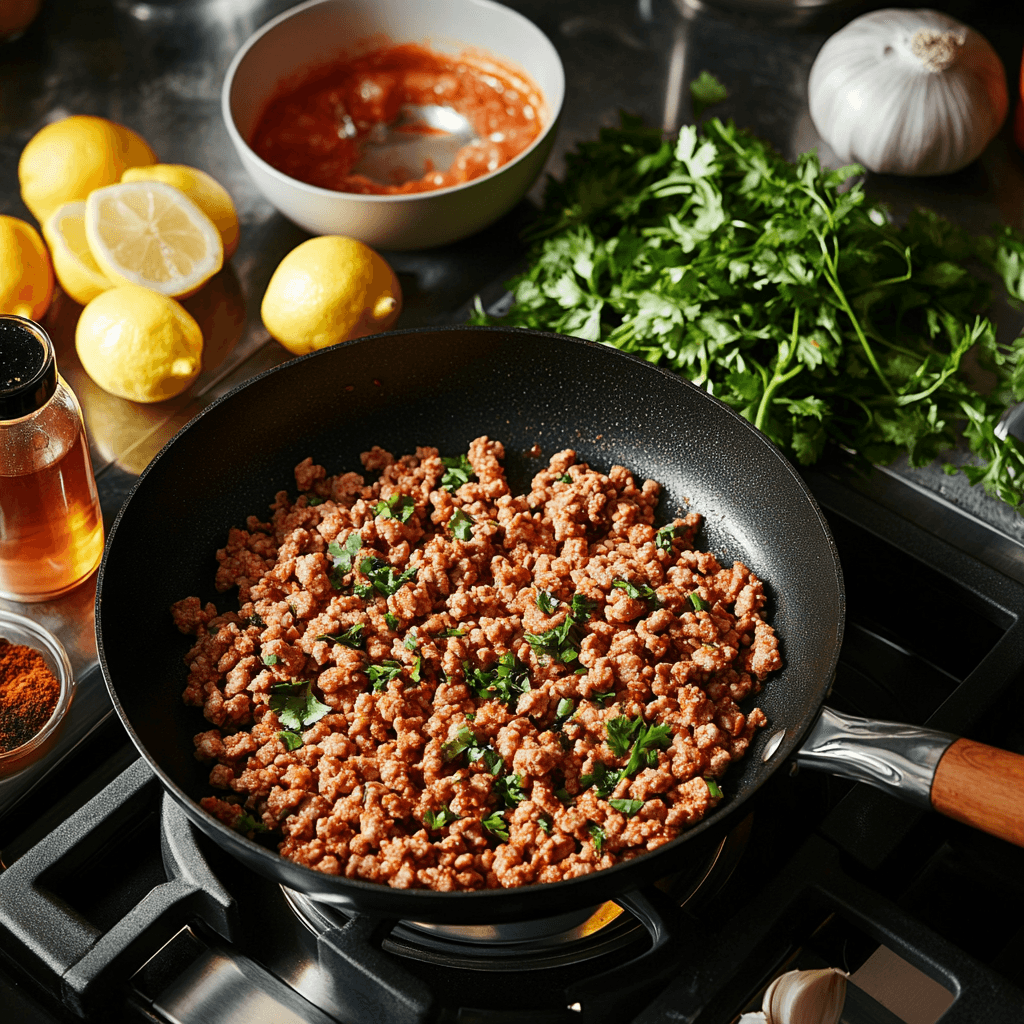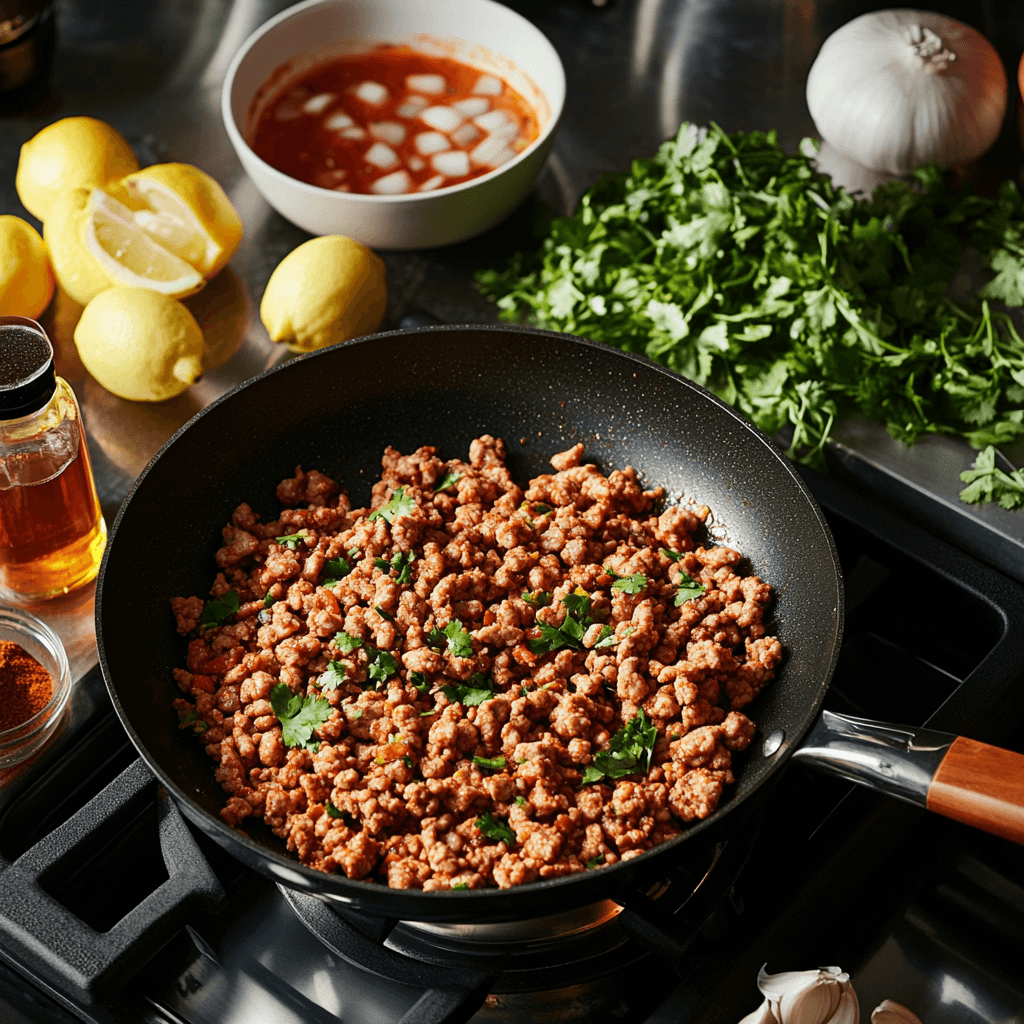Ground turkey recipes are a versatile and healthy choice for creating flavorful dishes. Whether you’re making tacos, meatballs, or stir-fry, ground turkey offers a lean protein option that pairs perfectly with various seasonings and ingredients. With the right techniques and combinations, you can turn ground turkey into a standout ingredient for any meal.
Table of Contents
Why Ground Turkey Is a Healthy Choice
Ground turkey is prized for its low fat content compared to ground beef or pork. It is rich in essential nutrients such as protein, B vitamins, and selenium, making it an excellent option for maintaining a balanced diet. Additionally, turkey is often recommended for those looking to manage cholesterol levels or maintain a heart-healthy lifestyle. Its ability to be seasoned and flavored in countless ways makes it a favorite among health-conscious cooks.
Common Challenges in Cooking Ground Turkey
While ground turkey offers numerous benefits, cooking it comes with its own set of challenges. Due to its low fat content, turkey can dry out quickly if overcooked. Achieving the perfect texture and flavor requires careful attention to cooking times and techniques. Additionally, its mild flavor means that it can taste bland without the right seasoning, which underscores the importance of understanding and enhancing its natural taste.
How to Add Flavor to Ground Turkey
Ground turkey recipes often face the challenge of balancing flavor due to the mild nature of the meat. With the right techniques, ingredients, and seasonings, however, you can transform ground turkey into a flavorful and versatile base for your favorite dishes. This guide explores how to enhance ground turkey’s taste, ensuring every dish shines with rich and satisfying flavors.
Understanding Flavor Profiles
Creating flavorful ground turkey recipes starts with understanding how to balance sweet, savory, and spicy elements. Sweetness from honey or brown sugar complements the natural taste of turkey, while garlic, onion, and soy sauce provide depth. Add a dash of heat with chili flakes or cayenne for a dynamic dish.
For more insight into seasoning balance, check out What Gives Sausage Its Flavor?, which explains how spices create complex flavor profiles.
Preparation Techniques for Better Flavor
Seasoning Properly: Always salt the turkey generously and use bold spices like paprika, cumin, or garlic powder to avoid blandness. Herbs like parsley or thyme further elevate the dish.
Using Marinades and Brines: A simple brine or marinade with acidic elements like vinegar or yogurt tenderizes the meat while infusing it with flavor.
Incorporating Aromatics: Sautéed garlic, onions, or bell peppers mixed into the turkey create depth and aroma, much like in hearty recipes such as Lamb Stew in the Instant Pot.
Cooking Methods That Enhance Flavor
Cooking techniques like browning and searing create a golden crust that locks in flavor. Using a cast iron pan or grilling can bring out smokier, deeper notes in the meat. For tips on how cooking methods affect food textures, read Best Cut of Lamb for Stew.
Flavor-Boosting Additives and Pairings
Pairing with Vegetables and Grains: Combine turkey with roasted vegetables or grains like quinoa to add flavor and texture, as seen in Ground Turkey Keto Recipes.
Sauces and Condiments: Soy sauce, Worcestershire, or barbecue sauces can add complexity to ground turkey recipes.
Cheese for Creaminess: Fold shredded cheese into patties or meatballs for a rich flavor boost.
Crunchy Textures: Incorporate toasted breadcrumbs or roasted seeds for added dimension.
Cooking Methods That Enhance Flavor
How you cook ground turkey is just as important as how you prepare it. Utilizing techniques like browning, grilling, and selecting the right cookware can make all the difference in achieving rich and satisfying flavors.
Browning and Searing Techniques
Browning ground turkey is a simple yet effective way to develop flavor through the Maillard reaction, which occurs when proteins and sugars in the meat caramelize. To achieve this, cook the turkey over medium-high heat in a hot pan without overcrowding. Avoid stirring too frequently, allowing the meat to form a golden crust. This crust not only enhances flavor but also adds a pleasing texture to the dish.
Grilling and Smoking for Depth
Grilling or smoking ground turkey infuses it with a smoky, charred flavor that complements its natural taste. Burgers, kebabs, or patties made from ground turkey benefit greatly from this method. If smoking, use wood chips like hickory or applewood for additional flavor complexity. The high heat of the grill also creates those delicious sear marks, adding a rustic appeal to your dish.
Using Cast Iron and Non-Stick Pans
The choice of cookware plays a significant role in the flavor outcome of ground turkey dishes. Cast iron pans are excellent for achieving a rich sear and maintaining even heat distribution. The heavy material locks in heat, creating a crisp crust on the outside of the turkey while keeping it moist inside. Non-stick pans, on the other hand, are great for cooking delicate mixtures or when using minimal oil, making cleanup easier without sacrificing flavor.

How to Add Flavor to Ground Turkey
Ground turkey is a versatile protein, but its mild flavor requires thoughtful preparation to make dishes stand out. By incorporating complementary additives, sauces, and creative ingredients, you can transform ground turkey into a flavorful and textured culinary masterpiece. Here are the best tips for amplifying the taste and appeal of ground turkey dishes.
Using Sauces and Condiments
Sauces and condiments are key to enhancing the flavor profile of ground turkey. Adding soy sauce, Worcestershire sauce, or fish sauce creates a deep umami base, while hot sauce or chili paste brings heat and complexity. Creamy sauces like tzatziki, yogurt, or sour cream balance spicy dishes, while barbecue or teriyaki glaze introduces a sweet and tangy twist.
For more ideas about sauce combinations, check out What Gives Sausage Its Flavor?, which explains how condiments and spices work together to create unique flavor profiles.
Adding Cheese for Creaminess
Cheese is a foolproof way to add richness and creaminess to ground turkey dishes. Fold shredded mozzarella, cheddar, or Parmesan into meat mixtures like burgers or casseroles for a velvety texture. For tangy enhancements, crumble soft cheeses like feta or goat cheese into the mix. Melty toppings like Swiss or provolone can elevate your dishes to new levels of indulgence.
For another comforting take on creamy textures, you might enjoy this guide to O’Charley’s Potato Soup Recipe.
Enhancing Texture with Crunchy Elements
A satisfying crunch can transform the texture of ground turkey dishes. Toasted breadcrumbs or crushed nuts like almonds or pecans can be mixed into patties or meatballs for added crispness. For toppings, try crispy bacon bits, fried onions, or roasted seeds, which introduce complexity and make your dishes more dynamic.
Need ideas for combining textures in your meals? Explore recipes like Lamb Stew in the Instant Pot for inspiration on blending softness with crunch in hearty dishes.
Pairing Ground Turkey with Other Ingredients
Ground turkey’s neutral flavor makes it an ideal base for pairing with other ingredients to create balanced and harmonious dishes.
Pairing with Vegetables for Balance
Vegetables are a natural companion to ground turkey, offering both nutritional balance and flavor variety. Bell peppers, zucchini, mushrooms, and spinach pair particularly well, adding moisture and earthiness. Roasted or sautéed vegetables bring out their natural sweetness, complementing turkey’s mild taste. For a burst of color and freshness, consider adding diced tomatoes, corn, or a mix of seasonal veggies.
Adding Grains and Legumes for Texture and Flavor
Grains and legumes are excellent additions to ground turkey dishes, enhancing both texture and flavor while making meals more filling. Quinoa, rice, or bulgur wheat can be used as a base or mixed directly into the turkey for burgers or meatloaves. Legumes like black beans, chickpeas, or lentils not only add a hearty texture but also boost the dish’s protein and fiber content. Combining turkey with grains or legumes creates a well-rounded dish suitable for a variety of diets.
Creative Recipes for Flavorful Ground Turkey
Ground turkey’s versatility makes it a perfect base for creative and flavorful recipes. Here are a few ideas to inspire your next meal, each bringing a unique twist to this lean protein.
Turkey Tacos with a Twist
Ingredients:
- 1 lb ground turkey
- 1 tbsp olive oil
- 1 packet taco seasoning or homemade blend
- 1/2 cup salsa (mild, medium, or spicy based on preference)
- 1/4 cup chopped cilantro
- Taco shells or tortillas
- Toppings: shredded lettuce, diced tomatoes, avocado slices, shredded cheese, and sour cream
Instructions:
- Heat olive oil in a skillet over medium heat. Add ground turkey and cook until browned, breaking it up with a spoon.
- Stir in taco seasoning and salsa, cooking for 3-5 minutes until the flavors meld.
- Remove from heat and mix in fresh cilantro.
- Serve the turkey mixture in taco shells or tortillas and top with your favorite toppings. For a twist, try using flavored tortillas or adding a squeeze of lime for extra zest.
Savory Turkey Meatballs
Ingredients:
- 1 lb ground turkey
- 1/3 cup breadcrumbs
- 1/4 cup grated Parmesan cheese
- 1 egg
- 2 cloves garlic, minced
- 1 tsp Italian seasoning
- Salt and pepper to taste
- Marinara sauce for serving
Instructions:
- Preheat your oven to 375°F (190°C) and line a baking sheet with parchment paper.
- In a mixing bowl, combine ground turkey, breadcrumbs, Parmesan, egg, garlic, Italian seasoning, salt, and pepper. Mix until well combined.
- Form the mixture into 1-inch meatballs and place them on the prepared baking sheet.
- Bake for 20-25 minutes until fully cooked and golden brown.
- Serve with warm marinara sauce over spaghetti or as an appetizer with dipping sauces.
Turkey Stir-Fry with Asian Flavor
Ingredients:
- 1 lb ground turkey
- 2 tbsp soy sauce
- 1 tbsp hoisin sauce
- 1 tbsp sesame oil
- 2 garlic cloves, minced
- 1 tbsp grated ginger
- 2 cups mixed vegetables (broccoli, bell peppers, carrots, snap peas)
- 1/4 cup chopped green onions
- Cooked rice or noodles for serving
Instructions:
- Heat sesame oil in a large skillet or wok over medium-high heat. Add garlic and ginger, sautéing until fragrant.
- Add ground turkey and cook until browned, breaking it apart with a spoon.
- Stir in soy sauce and hoisin sauce, then add the mixed vegetables. Cook for 5-7 minutes, stirring frequently, until the vegetables are tender but crisp.
- Garnish with green onions and serve over rice or noodles. For extra flavor, sprinkle with sesame seeds or a dash of chili oil.
Additional Tips for Perfect Stir-Fry
For the best results, use a hot wok or large skillet to ensure even cooking. Avoid overcrowding the pan, as this can steam the ingredients rather than searing them. For more detailed guidance on stir-frying techniques, check out this Guide to Stir-Frying Vegetables.
Recommended Pairings and Variations
- For a gluten-free version, use tamari instead of soy sauce and ensure the hoisin sauce is gluten-free.
- Add a touch of spice with Sriracha or crushed red pepper flakes, or explore other spicy condiments in this Asian Sauce Guide.
- Pair this dish with jasmine rice or soba noodles for an authentic Asian experience. Find more noodle options in this Noodle Buying Guide.
Nutritional Benefits of Ground Turkey
Ground turkey is a lean protein, making it a great choice for health-conscious meals. It’s low in fat and high in essential nutrients like B vitamins and selenium. To learn more about the nutritional benefits of turkey, visit Turkey Nutrition from USDA.


